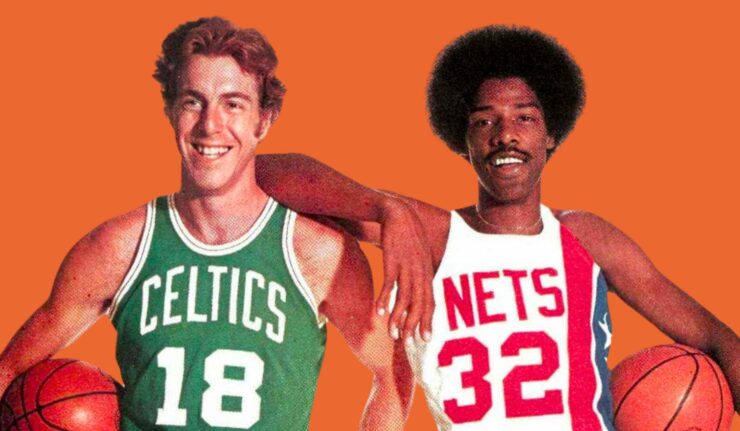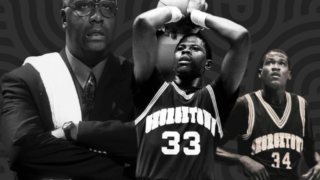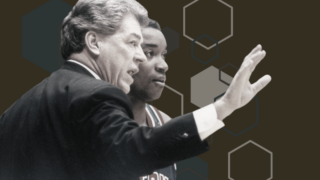It was more than just red-white-and-blue basketballs.
The ABA/NBA merger, a pivotal moment in the history of professional basketball, took place in 1976 and had a profound impact on the landscape of the National Basketball Association.
The merger not only brought about significant changes to the league’s structure but also introduced a wave of talented players from the American Basketball Association (ABA) to the NBA, shaping the future of the sport.
The ABA was established in 1967 as a rival league to the NBA, known for its innovative style of play, including the introduction of the three-point line and a red, white, and blue basketball. Despite its popularity, the ABA faced financial challenges, and by the mid-1970s, talks of a merger with the more established NBA began to gain traction.
The merger was officially completed in 1976, and four ABA franchises— the Denver Nuggets, Indiana Pacers, New York (later New Jersey) Nets, and San Antonio Spurs—were absorbed into the NBA. This expansion brought the total number of NBA teams to 22 and marked the beginning of a new era for professional basketball.
Several notable players made the transition from the ABA to the NBA as a result of the merger, leaving an indelible mark on the league. Here are some of the most famous players who made the jump:
Julius Erving (Dr. J)
A transcendent talent, Julius Erving was the face of the ABA and a three-time MVP. Known for his gravity-defying dunks and stylish play, Erving joined the Philadelphia 76ers in the NBA after the merger. He continued to dazzle fans with his athleticism and became an iconic figure in NBA history.
George Gervin (The Iceman)
Gervin, one of the most prolific scorers in the ABA, joined the San Antonio Spurs in the NBA. The silky-smooth shooting guard earned multiple scoring titles in both leagues and became a Hall of Famer. His impact on the Spurs’ franchise and the NBA at large was significant.
Moses Malone
Moses Malone began his professional career in the ABA as a teenager and quickly established himself as a dominant force. After the merger, he played for several NBA teams, including the Houston Rockets and Philadelphia 76ers. Malone went on to become a three-time NBA MVP and a Hall of Famer.
Artis Gilmore
A dominant center in the ABA, Artis Gilmore continued to excel in the NBA after the merger. He played for the Chicago Bulls and later the San Antonio Spurs, showcasing his shot-blocking prowess and rebounding ability. Gilmore left an enduring legacy as one of the premier big men of his era.
David Thompson
An explosive scorer, David Thompson made a seamless transition to the NBA after the merger. He played for the Denver Nuggets and later the Seattle SuperSonics. Thompson’s scoring ability and athleticism made him a standout player in both leagues.
Dan Issel
A versatile big man, Dan Issel had a successful career in both the ABA and NBA. After the merger, he continued to contribute to the success of the Denver Nuggets. Issel’s scoring and rebounding made him a valuable asset for his teams.
Dennis Johnson
Dennis Johnson, known for his defensive prowess and clutch performances, started his career in the ABA with the Seattle SuperSonics. After the merger, he played a key role for the Boston Celtics, where he became a vital part of multiple championship-winning teams.
Billy Cunningham
While not a player in the NBA, Billy Cunningham made a significant impact as a coach. After a successful playing career in the NBA, Cunningham coached the Philadelphia 76ers to an NBA championship in 1983. His coaching success further underscored the influence of ABA alumni on the league.
The influx of ABA talent significantly elevated the level of competition in the NBA. The players who transitioned from the ABA brought a unique flair and style of play, influencing the evolution of the league. The merger not only expanded the NBA’s reach but also enriched the league with a new generation of stars who would go on to leave a lasting legacy.
The ABA/NBA merger not only integrated four ABA franchises into the NBA but also seamlessly blended the talents of ABA players with those of the existing NBA stars. The result was a more robust, competitive, and entertaining league that set the stage for the NBA’s global dominance in the decades to come. The legacy of the ABA and its impact on the NBA can still be felt today, as the league continues to thrive with an international fan base and a rich history shaped by the convergence of basketball’s two premier leagues.




